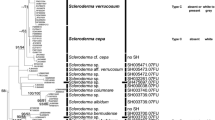Abstract
The ultrastructure of developing and mature sclerotia ofSclerotium rolfsii was studied with a scanning electron microscope. The mature sclerotium is disconnected from the mycelium and well differentiated. The rind is composed of rather thick-walled empty cells. The cortex cells are large and almost completely filled with vesicles, whereas the medullar cells are smaller and some of them are very thickwalled.
Similar content being viewed by others
References
Arimura, M., and Kihara, H. 1968. Ultrastructure ofSclerotinia sclerotiorum DeBary.Mem. Fac. Agric. Kagashima Univ. 6:79–88.
Brown, M. F., and Wyllie, T. D. 1970. Ultrastructure of microclerotia ofVerticillium albo-atrum.Phytopathol. 60:538–542.
Chet, I. 1969. The role of sclerotial rind in the germinability of sclerotia ofSclerotium rolfsii.Can. J. Bot. 47:593–595.
Chet, I., and Henis, Y. 1969. Effect of catechol and Na2 EDTA on melanin content of hyphal and sclerotial walls ofSclerotium rolfsii Sacc. and the role of melanin in the susceptibility of these walls toβ-(1–3) glucanase and chitinase.Soil Biol. Biochem. 1:131–138.
Chet, I., and Henis, Y. 1975. Sclerotial morphogenesis in fungi.Ann. Rev. Phytopathol. 13: in press.
Chet, I., Henis, Y., and Mitchell, R. 1966. The morphogenetic effect of sulfur amino acids, glutathione and iodoacetate onSclerotium rolfsii, J. Gen. Microbiol. 45:541–546.
Chet, I., Henis, Y., and Mitchell R. 1967. Chemical composition of hyphal and sclerotial walls ofSclerotium rolfsii.Can. J. Microbiol. 13:137–141.
Chet, I., Henis, Y. and Kislev, N. 1969. Ultrastructure of sclerotia and hyphae ofSclerotium rolfsii Sacc.J. Gen. Microbiol. 57:143–147.
Chet, I., and Kislev, N. 1974. Scanning electron microscopy of spherules ofPhysarum polycephalum.Tissue and Cell 5:545–551.
Chet, I., Retig, N., and Henis, Y. 1972. Changes in total soluble proteins and in some enzymes during morphogenesis ofSclerotium rolfsii as detected by the gel isoelectric focusing technique.J. Gen. Microbiol. 72:451–456.
Colotelo, N. 1974. A scanning electron microscope study of developing sclerotia ofSclerotium rolfsii.Can. J. Bot. 52:1127–1130.
Kislev, N., and Chet, I. 1974. Scanning electron microscopy of freeze-fractured sclerotia ofPhysarum polycephalum.Tissue and Cell 6:209–214.
Okon, Y., Chet, I., and Henis, Y. 1972. Lactose induced synchronous sclerotium formation inSclerotium rolfsii and its inhibition by ethanol.J. Gen. Microbiol. 71:465–470.
Townsend, B. B., and Willetts, H. J. 1954. The development of sclerotia of certain fungi.Trans. Br. Mycol. Soc. 37:213–221.
Willetts, H. J. 1972. The morphogenesis and possible evolutionary origins of fungal sclerotia.Biol. Rev. 47:515–536.
Wyllie, T. D., and Brown, M. F. 1970. Ultrastructural formation of sclerotia ofMacrophomina phaseoli.Phytopathol. 60:524–528.
Author information
Authors and Affiliations
Rights and permissions
About this article
Cite this article
Chet, I. Ultrastructural basis of sclerotial survival in soil. Microb Ecol 2, 194–200 (1975). https://doi.org/10.1007/BF02010439
Issue Date:
DOI: https://doi.org/10.1007/BF02010439




